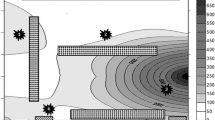Abstract
Fungi inhabiting household environments in the West, East and Central localities of Riyadh city were screened. The screened area included bedrooms, drawing rooms, living rooms, kitchens and bathrooms. The common genera of fungi isolated wereAlternaria, Aspergillus, Cercospora, Chaetomium, Cladosporium, Curvularia, Drechslera, Embellisia, Fusarium, Mucor, Penicillium, Rhizopus, Scytalidium, Trichoderma, Torula andUlocladium. Two uncommon generaNodulosporium andOidiodendron for Saudi Arabian mycoflora were also isolated. In all the localities, the highest number of fungal colonies per plate or per gram were found in the living rooms, followed by bedrooms. The number of colonies per plate or per gram was in general higher in densely populated than in less populated areas.
Similar content being viewed by others
References
Price JA, Reiser J, Longbottom JL, Warner JO. Inhalant allergy in asthmatic children: Skin Prick Test. Radioallergosorbenttest and chemiluminescent assay compared with allergen levels in their mattress dust. Int Arch Allergy Appl Immunol 1989; 88: 183–184.
Rijckaert G. Exposure to fungi of modern homes. Allergy 1981; 36: 277–278.
Mori M, Ogami Y, Takahashi T. Microbial contamination of carpet dust in private houses. J. Antibact Antifung Agents 1985; 13: 109–117.
Schoeber G. The influence of the water activity of culture media on the isolation of fungi from house dust. Mycoses 1988; 31: 255–258.
Krillis, S, Baldo BA, Basten A. Analysis of allergen-specific Immunoglobin E response in 341 allergic patients association between allergens and between allergen groups and clinical diagnosis. Aust New Zealand J Med 1985; 15: 421–426.
Chirila M, Florescu L, Popescu M, Capetti E, Panait E. The frequency of allergens implicated in bronchial asthma in different areas of Romania. Rev Roum Med Intern Med 1984; 22: 141–146.
Al-Fryah A, Hasnain SM, Harfi HA. Respiratory allergy and aero-allergens in Saudi Alabia. J Allergy Clin Immunol 1989; 83: 198–201.
Bronswijk JEMH, George-Gridelet DS, Lustgraaf BV. An evolution of biological methods in house dust allergen research. Allerg Immunol (Leipz) 1986; 24: 18–22.
Agarwal MK, Jones BS, Yunginger JKI. Shared allergic and antigenic determinants inAlternaria andStemphyllium extracts. J Allergy Clin Immunol 1982; 437–444.
Al-Doory Y, Domson JF. Mould allergy. Philadelphia: Lea and Febiger, 1984.
Rafii ZS. Sinusitis in Saudi Children. Ann Saudi Med 1990; 10: 504–507.
Bokhary HA, Parvez S. Soil mycoflora from truffle native areas of Saudi Arabia. Mycopathologia 1992; 118: 103–107.
Bokhary, HA, Parvez S. Soil mycoflora from wild desert truffle habitats in northern Saudi Arabia. J. Arid Env 1992; 23: 1–9.
Ellis MB. Dematiaceous hyphomycetes. Kew, UK: CMI, 1971.
Ellis MB. More Dematiaceoushyphomycetes. Kew, UK: CMI, 1976.
Ramirez C. Manual and Atlas of Penicillia. Amsterdam: Elsevier, 1982.
Raper KB, Fennell DT. The genusAspergillus. Baltimore: Williams & Wilkins, 1965.
Zycha H, Siepmann R, Linneman G. Mucorales. J Cramer, 1969.
Gilman JC. A manual of soil fungi. AMES, IA: The Iowa State University Press, 1971.
Carmichael JW, Kendrick WB, Conners IL, Sigler L. Genera of hyphomycetes. The University of Alberta Press, 1980.
Nelson PE, Toussoun TA, Marassas WFO.Fusarium species. An illustrated manual for identification. The Pennsylvania State University Press, 1983.
Pitt JI. The genusPenicillium and its teleomorphic stateEupenicillium andTalaromyces. London: Academic press, 1979.
Schipper MAA. On certain species ofMucor with a key to all accepted species. Stud Mycol 1978; 17: 1–52.
Anokute, CC. Principles of epidemiology. Riyadh, Saudi Arabia: King Saud University Press, 1991.
Baggy MMK, Gohar YM. Mycoflora of air-conditioners dust from Riyadh, Saudi Arabia. J Basic Microbiol 1988; 28: 571–577.
Palmgren MS, Lee LS, Delucca AJ, Ciegler A. Preliminary study of mycoflora and mycotoxin in grain-dust from New Orieans area grain elevators. Am Ind Hyd Assoc J 1983; 44: 485–488.
Robert AH, David MW, William RB, Odette LS. Viable fungi in corn dust. Appl Environ Microbiol 1984; 47: 84–87.
Abdel-Hafez SII, Shroeit AAM. Mycotoxins-producing fungi and mycoflora of air-dust from Taif, Saudi Arabia. Mycopathologia 1985; 92: 65–71.
Abdel-Hafez SII, Shroeit AAM, Abdel-Hafez AII, Maghrabi OMO. Mycoflora and mycotoxin-producing fungi of air-dust particles from Egypt. Mycopathologia 1986; 93: 25–32.
Hamada N, Yamada A. Seasonal change in the fungal flora of house dust. Trans Mycol Soc Japan 1991; 32: 45–53.
Chapman JA, Aeroallergens of southeastern Missouri, USA. Grana 1986; 25: 235–46.
Samson RA, Lustgraaf B. van der.Aspergillus penicillioides andEurotium halopilicum in association with house-dust mites. Mycopathologia 1978; 64: 13–6.
Ali-Shatayel MS, Arda HM. Isolation of keratinophilic fungi from floor dust in Arab elementary and preparatory schools in the west Bank of Jordan. Mycopathologia 1989; 106–111.
Mercantini R, Marsella R, Larnbiase L, Belardi M. Isolation of keratinophilic fungi from floors in Roman kindergarten and secondary schools. Mycopathologia 1985; 94: 109–115.
Mercantini R, Marsella R, Lambiase L, Fulvi F. Isolation of keratinophilic fungi from floors in Roman primary schools. Mycopathologia 1983; 82: 115–120.
Saad RR, El-Gindy AA. Fungi of the house dust in Riyadh, Saudi Arabia. Zentrabl Mikrobiol 1990; 145: 65–68.
Author information
Authors and Affiliations
Rights and permissions
About this article
Cite this article
Bokhary, H.A., Parvez, S. Fungi inhabiting household environments in Riyadh, Saudi Arabia. Mycopathologia 130, 79–87 (1995). https://doi.org/10.1007/BF01103454
Received:
Accepted:
Issue Date:
DOI: https://doi.org/10.1007/BF01103454




